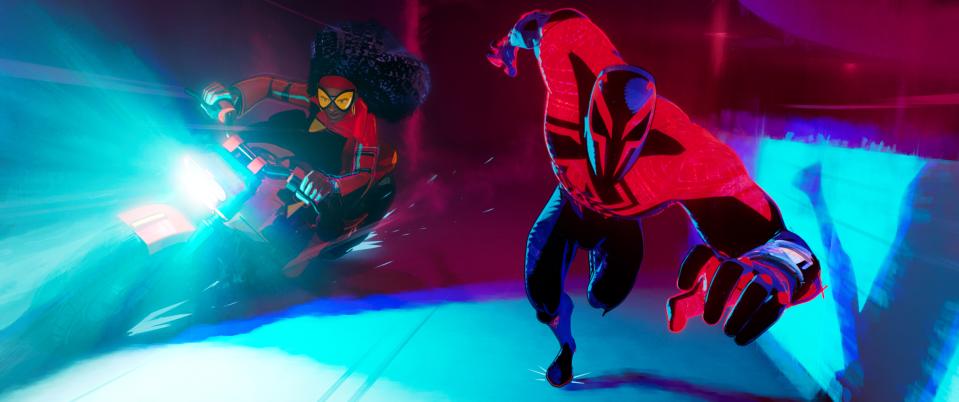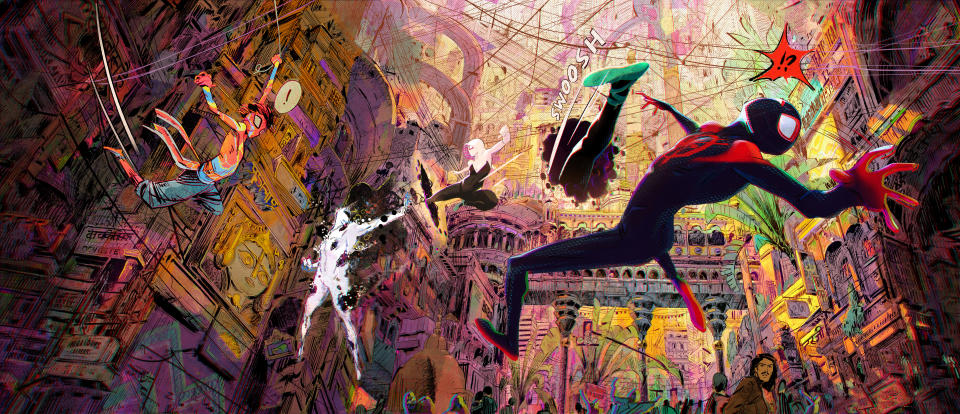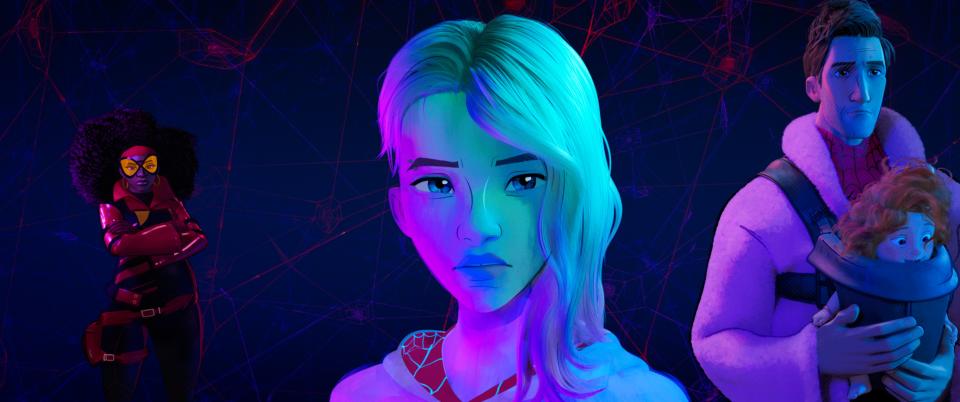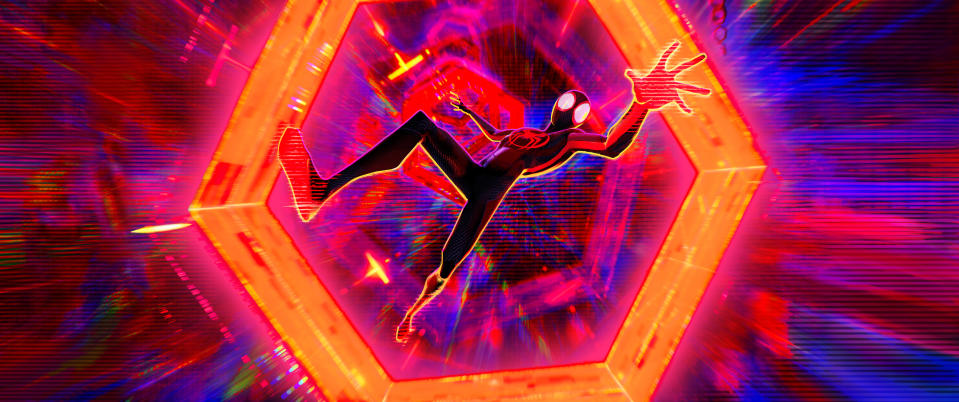‘Across the Spider-Verse’ Added 3 New Directors to Continue the Epic Coming-of-Age Story

The complexity of “Spider-Man: Across the Spider-Verse” became evident even prior to the completion of its ground-breaking, Oscar-winning predecessor, “Into the Spider-Verse,” so producers Phil Lord and Chris Miller recruited three new directors, who eagerly asked to join the franchise: Joaquim Dos Santos (“The Legend of Korra”), Kemp Powers (“Soul” co-director and “One Night in Miami” Oscar-nominated screenwriter), and Justin K. Thompson (“Into the Spider-Verse” production designer). The producers called them their “band of musicians,” with each contributing his own creative specialty in helping Miles Morales forge his own Spidey path in this epic sequel (which concludes with “Beyond the Spider-Verse,” opening March 29, 2024).
Dos Santos choreographed the thrilling action sequences as Miles (Shameik Moore) travels through several multiverses with potential love interest Gwen Stacy (Hailee Steinfeld) and the Spider-Society team led by Oscar Isaac’s Miguel O’Hara. Their worlds are threatened by Spot/Dr. Jonathan Ohnn (Jason Schwartzman), who harnesses the power of a super Collider and traverses time and space through inter-dimensional portals on his body.
More from IndieWire
Oscar Isaac Wants Pedro Pascal to Voice an 'Old, Cranky Spider-Person' in a 'Spider-Verse' Movie
'Spider-Man: Across the Spider-Verse' and 'Past Lives': The Portrait of a Healthy, Happy Box Office
Powers provided emotional gravitas by sharpening the cultural authenticity of Miles as a superhero of color and the universality of his coming-of-age story. He particularly honed in on the importance of family, individual expression, and collaborative teamwork.
Thompson brought a keen understanding of world-building and contributed to every faced of the production with the introduction of five new Spidey dimensions: the watercolor-inspired Earth-65, from which Gwen’s Spider-Woman hails; Mumbattan, a mashup of Mumbai and Manhattan, home to Pavitr Prabhakar (Karan Soni); the futuristic brutalism of Nueva York, where Miguel runs Spider-Society HQ; the punk poster collage look of New London, inhabited by Daniel Kaluuya’s Hobie; and a dark and gritty place that will remain spoiler free.

But while the 1,000-member crew at Sony Pictures Imageworks continued to set new industry standards in 2D stylization for CG, the directors focused on Miles’ emotional arc. “I think, for us, the throughline was: Can we track Miles’ journey through this?” Dos Santos told IndieWire. “The answer was yes, we hope that sticks. And if the repeat viewing means, ‘Hey, I gotta go see what that little editorial blurb in the corner was that flashed on here for a second, or the millions of characters,’ then bring it on.”
Powers was eager to see where they could take Miles after a growth spurt at 15. “One of the things that really excited me about it was the time jump, the fact that we go a year and a half into the future,” he told IndieWire. “On a personal note, at the time we started on this film, my son was the same age as Miles. So I witnessed the growth spurt and how it’s weird to have your kid grow like seven inches in one year and go from an adolescent to a dude with a beard in your house.”
Powers was also intrigued about the Spider-Man credo of loneliness and sacrifice and how Miles transcends it. “As you saw in the first film, he’s got both parents, and he’s close to his family,” he continued. “He became Spider-Man as part of a team with other people who mentor him, and they’re all gone. There was a lot of wonderful, rich stuff dramatically we knew we wanted to mine in this story.”

Making the film became personal for Dos Santos, too, because, for the first time, his son pulled his hand away from him while with a friend. “My heart was crushed,” he said. “And something that small, carrying that emotion through the big stuff, is how you make that big stuff matter.” During test screenings, he even noticed how engaged parents were in the film because of the authenticity of their perspective.
“These are famous, important characters,” added Powers. “But the reality is, as filmmakers, we start from a place of ourselves and putting our own experiences into it. That’s what makes it authentic, because I come from a place where I believe these are universal, human things that everyone in the world, not just Americans, is going to be dealing with. So, as specific as the characters are, as unique as the characters are, everyone wants the same things for themselves and their families and their kids. It makes you empathetic and it makes you connect with those characters.”
This authenticity no doubt accounts for the emotional depth in the scenes between Miles and his dad (Brian Tyree Henry) and Gwen and hers (Shea Whigham), cops torn between professional and personal duty. But what makes these domestic conflicts work so well in animation is the visual contrast between the close-knit, gentrified Brooklyn for Miles and the impressionistic, closed-off mood rings surrounding loner Gwen.
There’s also Miles’ struggle with Miguel, who believes in the importance of sticking to canon: If someone is destined to die, you don’t intervene because it will disrupt the Spider-Verse. Whereas Miles believes there is no such thing as canon and you should save everyone.

“It was important to us emotionally that we understand why [Miguel] makes the choices he’s making,” Thompson told IndieWire. “And I think that’s the great thing about making a ‘Spider-Verse’ film. No matter how big the spectacle gets, no matter how complex the visuals get, no matter how cool the action gets, there’s always emotion driving every choice we’re making.”
It was even more important to flesh out the motivations of Spot, who starts out as a joke to Miles because of his ineptness but eventually becomes a serious threat. He’s the perfect example of form as function and required his own toolset: As his design evolves from a rough sketch with blue construction lines to a fully formed character, he gains control of his inky black portals to unleash the power he possesses.
“Walking into the room, you saw a sketch on the thing, and then it started moving, and you didn’t realize that in order to recognize human movement that we relate to, all you need is half a squiggle,” Dos Santos said. “And as we started doing these experiments, I think the most exciting thing for us was that we were given so much permission to support Miles’ journey. We transferred that permission onto the crew. And once they started seeing our reactions to these little experiments, they started doing some more on their own.”
Among the most fun was the Mumbattan sequence, which began with researching the Spider-Man India comics and translating that into a unique action-packed, 2D-looking tapestry. They were densely illustrated on special paper, inked very quickly where colors went outside the lines, and then offset printed for a bizarre effect. It took new tools for simulation, linework, and non-photorealistic compositing to pull it off.

“And there were all these people on our crew,” Thompson said, “these Indian animators, and visual development artists, and character designers and painters, who came and told us this is what we grew up with. And this is like the comics.”
“Some of my favorite things are very subtle, like when the Alchemax building breaks away,” Powers added. “The first time I saw that fully lit, I loved how illustrative that line work was. That we figured out and got in there at the last minute, and during an action sequence you’re gonna have a lot of that.”
Fortunately, the producers and directors realized early on that there was too much story to pack into one film, so they split it into two parts and formed a trilogy. But the element they worked on the most was how to tell a complete story with a proper arc for the middle section in the tradition of “The Empire Strikes Back.”
“What questions are we gonna leave unanswered?” Dos Santos said. “In my personal experience, whenever there’s a trilogy, I tend to love the middle movies because you can be a little bit darker and you can push things a lot more narratively.”
Best of IndieWire
Sign up for Indiewire's Newsletter. For the latest news, follow us on Facebook, Twitter, and Instagram.

 Yahoo Sports
Yahoo Sports 